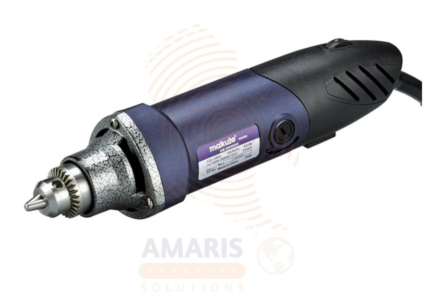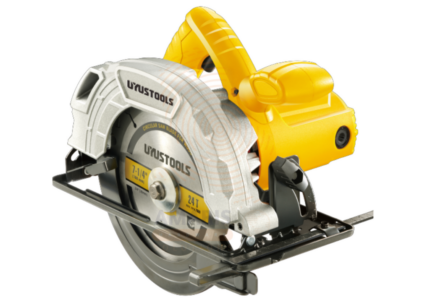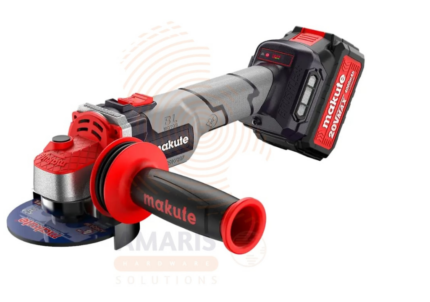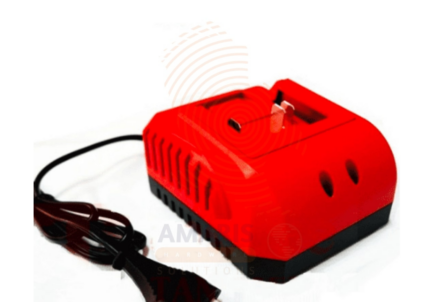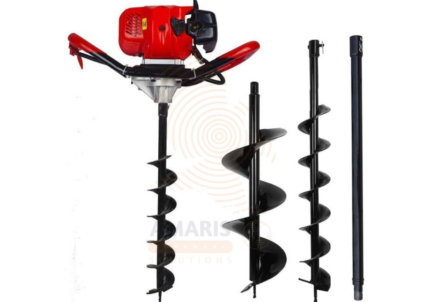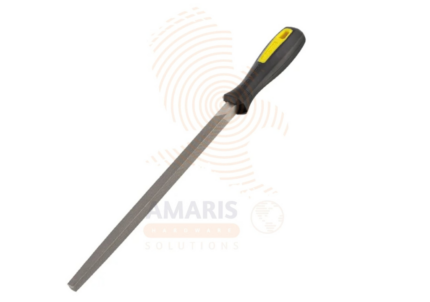
Round Hand File
$14.73 Original price was: $14.73.$13.99Current price is: $13.99.

Router Bit Set
$28.77 Original price was: $28.77.$27.33Current price is: $27.33.
Router
$65.00 Original price was: $65.00.$61.75Current price is: $61.75.
WhatsApp Order
A router is a versatile woodworking device designed for shaping, trimming, and hollowing out various materials, primarily wood. It consists of a motorized spindle that spins a cutting bit at high speeds. Routers are commonly used to create decorative edges, dadoes, grooves, and intricate patterns on wooden surfaces. They come in both handheld and table-mounted configurations, offering precision and control for tasks such as joinery, molding, and cabinetry. The router’s versatility makes it an essential tool in woodworking, allowing craftsmen to achieve a wide range of designs and finishes.
Category: POWER TOOLS
Tags: edge trimming, handheld router, power router, precision cutting, router bit, wood router, woodworking tool
Description
Table of Contents
ToggleRouter
Uses
-
Edge Profiling: Routers are commonly used to shape and create decorative edges on wooden boards and panels. This is useful for enhancing the aesthetic appeal of furniture and other wooden projects.
-
Joinery: Routers are essential for creating precise and strong joints, such as dovetails, mortise and tendon joints, and finger joints. They contribute to the overall structural integrity of woodworking projects.
-
Rabbeting and Grooving: Routers are employed to cut rabbets (shoulders along the edge of a board) and grooves (channels or slots) for various purposes, including fitting panels, creating recesses, and accommodating hardware.
-
Dadoes and Rebates: Routers are used to cut dadoes (rectangular grooves across the grain) and rebates (similar to rabbets but with two opposing shoulders). These features are often required for shelving and cabinet construction.
-
Molding and Trim Work: Routers can shape wood to create various moldings and trims, adding decorative elements to furniture, cabinets, and architectural details.
-
Hollowing Out: Routers can hollow out areas in wood, creating bowls, trays, and other concave shapes. This is especially useful for artistic and functional woodworking projects.
-
Lettering and Inlay Work: Routers equipped with special bits can be used for carving letters and creating intricate inlay work, adding personalized details to wooden surfaces.
-
Router Table Applications: When mounted to a router table, routers become even more versatile. They can be used for tasks such as edge jointing, making raised panel doors, and performing more intricate and controlled operations.
-
Template Routing: Routers are frequently used with templates to duplicate shapes or patterns, ensuring consistency in production and reducing the margin of error.
-
Surface Smoothing: Routers equipped with appropriate bits can be used for surface planing, ensuring a smooth and even finish on large wooden surfaces.
-
Laminate Trimming: Routers excel at trimming excess material from laminates and veneers, providing a clean and precise edge.
-
DIY and Home Improvement: Routers are valuable tools for individuals involved in DIY projects and home improvement, allowing them to achieve professional-level finishes and details in their woodworking endeavors.
SAFETY HANDLING PRECAUTIONS
Safety Precautions
-
Read the Manual:
-
Familiarize yourself with the router's user manual to understand its specific features, limitations, and safety guidelines.
-
-
Wear Personal Protective Equipment (PPE):
-
Always wear appropriate PPE, including safety glasses or goggles to protect your eyes from debris, and hearing protection as routers can be noisy.
-
-
Dust Collection:
-
Use a dust collector or wear a dust mask to minimize inhalation of sawdust and debris generated during routing. This helps maintain a clean and healthy workspace.
-
-
Secure Workpiece:
-
Ensure the workpiece is securely fastened to the work surface using clamps or other suitable methods. A stable workpiece reduces the risk of kickbacks and other accidents.
-
-
Router Bit Inspection:
-
Check the router bit for any damage or defects before use. Make sure it is sharp and properly secured in the collet. Replace any worn or damaged bits.
-
-
Collet and Chuck Safety:
-
Follow the manufacturer's instructions for installing and tightening router bits in the collet. Ensure the collet and chuck are properly secured to prevent bit slippage during operation.
-
-
Router Speed and Feed Rate:
-
Adjust the router speed and feed rate according to the material being worked on. Using the correct settings helps maintain control and produces cleaner cuts.
-
-
Direction of Rotation:
-
Be aware of the direction of the router bit rotation. Feed the material against the rotation to prevent kickbacks.
-
-
Start the Router Away from the Material:
-
Start the router with the bit clear of the material, and then carefully move it into the workpiece. This helps prevent sudden movements and improves control.
-
-
Two-Hand Operation:
-
Whenever possible, use both hands to operate the router for better stability and control. Keep one hand on the handles and the other on the router's body.
-
-
Router Table Safety:
-
If using a router table, ensure it is stable and securely mounted. Follow safety guidelines for table routing, including using push blocks and sticks for small workpieces.
-
-
Keep Hands Clear:
-
Keep your hands and body clear of the cutting area. Use push sticks or other tools to guide the material, especially when working with smaller pieces.
-
-
Disconnect Power:
-
Disconnect the power source before changing router bits or making adjustments to the tool. This prevents accidental startups.
-
-
Maintenance:
-
Regularly inspect and maintain your router. Keep it clean, lubricate moving parts, and replace any worn or damaged components promptly.
-
-
Training:
-
Ensure that operators are properly trained in the use of the router. Novice users should seek guidance from experienced individuals before attempting complex tasks.
-
Related products
Chuck Die Grinder
A Chuck Die Grinder is a handheld power tool equipped with a collet or chuck that holds a rotary burr or abrasive head. This tool is commonly used for precision grinding, polishing, and shaping of metal, wood, plastic, and other materials. Chuck Die Grinders are versatile and compact, allowing for intricate and detailed work in various applications, including metalworking, woodworking, and fabrication. They are widely employed in industries such as machining, automotive, and aerospace, as well as by hobbyists and craftsmen for tasks requiring fine control and high-speed material removal.
Circular Saw
A circular saw is a power tool equipped with a rotating circular blade, typically with teeth along its edge, designed for cutting various materials such as wood, plastic, metal, or masonry. It is commonly used in carpentry, construction, and other applications to make straight or beveled cuts with precision and efficiency. The circular saw is versatile and can be handheld or mounted on a table or other stationary surface, depending on the specific model and intended use.
Circular Saw Blade for Aluminum
A circular saw blade for aluminum is a cutting tool specifically designed for use with a circular saw to cut through aluminum materials. It features specialized teeth and design elements to optimize the cutting process for aluminum, which has different characteristics compared to wood or other materials. These blades typically have a high tooth count, often with specially shaped teeth, and may incorporate coatings or materials that reduce heat buildup during cutting. The goal is to provide efficient and clean cuts through aluminum while minimizing the risk of overheating or material deformation.
Cordless Angle Grinder
A cordless angle grinder is a handheld power tool designed for cutting, grinding, and polishing materials, typically metal or masonry. Unlike traditional angle grinders that are powered by electrical cords, cordless angle grinders are equipped with rechargeable batteries, providing greater mobility and flexibility in various work environments. These tools often feature a rotating disc or wheel that can be fitted with different abrasive attachments, allowing users to perform a variety of tasks such as cutting metal, smoothing welds, or removing rust and paint. Cordless angle grinders are widely used in construction, metalworking, and fabrication applications.
Cordless Blower
A cordless blower is a handheld or backpack device designed for the purpose of moving air to clean or clear debris, leaves, or other materials from outdoor spaces. Unlike traditional blowers that are powered by an electrical cord, cordless blowers are equipped with rechargeable batteries, providing greater mobility and flexibility in use. These devices are commonly used in landscaping, gardening, and yard maintenance to efficiently and conveniently blow away leaves, grass clippings, and other lightweight debris without the limitations of a power cord.
Fast Charger
A fast charger is a device designed to quickly recharge compatible batteries with a voltage rating of 20 volts. The "fast" designation implies that the charger is engineered to deliver a higher charging current, allowing for a more rapid replenishment of the battery's energy capacity compared to standard chargers. This type of charger is commonly used for power tools, electronic devices, or other equipment that operates on 20V batteries, providing users with a more efficient and time-saving charging solution.
Flat Knotted Wire Wheel
PRODUCT DESCRIPTION
A knotted wire wheel refers to a rotating tool used in various applications, typically in metalworking and surface preparation. It consists of a wheel-shaped assembly with wire bristles that are tightly twisted or "knotted" together. The wire bristles can be made of steel or other durable materials, and they are arranged in a radial pattern around the wheel.
Knotted wire wheels are commonly attached to power tools such as angle grinders or bench grinders. They are employed for tasks like removing rust, paint, scale, or other surface contaminants from metal surfaces, as well as for deburring or blending welds. The tightly twisted configuration of the wire bristles enhances the wheel's durability and effectiveness in tackling tough materials and applications.
These wheels are available in various sizes and designs to suit different tasks, and they are known for their abrasive action, making them valuable tools in metal fabrication, construction, and maintenance work.
Gasoline Auger Machine
A gasoline auger machine is a power tool designed for drilling holes in the ground using a rotating helical screw blade, commonly known as an auger. Unlike electric or manual augers, a gasoline auger machine is powered by a gasoline engine, providing greater mobility and independence from electrical power sources. This type of machine is commonly used in construction, landscaping, and agriculture for tasks such as digging holes for fence posts, planting trees, or installing various types of foundations. The gasoline engine provides the necessary power to turn the auger bit efficiently, making it suitable for heavy-duty and remote applications where access to electricity may be limited.


 Acrylic Sealants
Acrylic Sealants Construction Adhesives
Construction Adhesives Double-Sided Tape
Double-Sided Tape Duct Tape
Duct Tape Electrical Tape
Electrical Tape Epoxy & Resins
Epoxy & Resins Masking Tape
Masking Tape
 Automotive Wrenches & Socket Sets
Automotive Wrenches & Socket Sets Battery Chargers & Jump Starters
Battery Chargers & Jump Starters Car Jacks & Stands
Car Jacks & Stands Car Wash & Detailing Products
Car Wash & Detailing Products Diagnostic Tools
Diagnostic Tools Tire Inflators
Tire Inflators Vehicle Lighting
Vehicle Lighting Oil & Lubricants
Oil & Lubricants
 Adhesives & Sealants
Adhesives & Sealants Bricks & Blocks
Bricks & Blocks Cement & Concrete
Cement & Concrete Drywall & Plaster
Drywall & Plaster Flooring (Tiles, Wood, Laminate)
Flooring (Tiles, Wood, Laminate) Lumber & Plywood
Lumber & Plywood Paints, Primers & Coatings
Paints, Primers & Coatings Insulation Materials
Insulation Materials Roofing Materials
Roofing Materials
 Circuit Breakers
Circuit Breakers Electrical Cables & Wires
Electrical Cables & Wires Switches & Sockets
Switches & Sockets Fuses & Relays
Fuses & Relays Connectors & Terminals
Connectors & Terminals Electrical Boxes & Panels
Electrical Boxes & Panels Conduit & Fittings
Conduit & Fittings Lighting Fixtures & Bulbs
Lighting Fixtures & Bulbs Extension Cords & Power Strips
Extension Cords & Power Strips
 Anchors
Anchors Bolts
Bolts Clips & Clamps
Clips & Clamps Screws
Screws Nuts
Nuts Washers
Washers Rivets
Rivets Nails
Nails Threaded Rods
Threaded Rods
 Hammers
Hammers Measuring Tools (Tapes, Levels, Calipers)
Measuring Tools (Tapes, Levels, Calipers) Screwdrivers
Screwdrivers Pliers & Cutters
Pliers & Cutters Saws & Blades
Saws & Blades Chisels & Punches
Chisels & Punches Allen Keys & Hex Keys
Allen Keys & Hex Keys Ratchets & Socket Sets
Ratchets & Socket Sets Wrenches & Spanners
Wrenches & Spanners
 Power Tool Accessories (Blades, Bits, Discs)
Power Tool Accessories (Blades, Bits, Discs) Rotary Tools
Rotary Tools Saws (Circular, Jigsaw, Reciprocating)
Saws (Circular, Jigsaw, Reciprocating) Drills & Drivers
Drills & Drivers Grinders & Sanders
Grinders & Sanders Heat Guns
Heat Guns Nail Guns
Nail Guns Impact Wrenches
Impact Wrenches Batteries & Chargers
Batteries & Chargers
 Pipes & Fittings (PVC, Copper, PEX)
Pipes & Fittings (PVC, Copper, PEX) Plumbing Tools
Plumbing Tools Pumps & Motors
Pumps & Motors Sealants & Adhesives for Plumbing
Sealants & Adhesives for Plumbing Valves & Taps
Valves & Taps Water Heaters
Water Heaters Drainage Systems
Drainage Systems Faucets & Fixtures
Faucets & Fixtures Hoses & Tubing
Hoses & Tubing
 Hinges & Latches
Hinges & Latches Hooks & Brackets
Hooks & Brackets Window Hardware
Window Hardware Chains & Cables
Chains & Cables Casters & Wheels
Casters & Wheels Shelving & Storage Systems
Shelving & Storage Systems Door Handles & Locks
Door Handles & Locks Drawer Slides & Cabinet Hardware
Drawer Slides & Cabinet Hardware
 Personal Protective Equipment (PPE)
Personal Protective Equipment (PPE) Respirators & Masks
Respirators & Masks Safety Glasses
Safety Glasses Safes
Safes Security Cameras
Security Cameras Gloves
Gloves Helmets
Helmets Ear Protection
Ear Protection Fire Safety Equipment
Fire Safety Equipment Locks & Padlocks
Locks & Padlocks Motion Sensors & Alarms
Motion Sensors & Alarms
 Garden Fencing
Garden Fencing Garden Furniture Hardware
Garden Furniture Hardware Lawn Mowers
Lawn Mowers Trimmers & Edgers
Trimmers & Edgers Shovels & Spades
Shovels & Spades Rakes & Hoes
Rakes & Hoes Pruning Shears & Loppers
Pruning Shears & Loppers Watering Systems (Hoses, Sprinklers, Nozzles)
Watering Systems (Hoses, Sprinklers, Nozzles)
 Interior Paints
Interior Paints Paint Brushes & Rollers
Paint Brushes & Rollers Paint Strippers & Thinners
Paint Strippers & Thinners Paint Trays & Accessories
Paint Trays & Accessories Exterior Paints
Exterior Paints Spray Paints
Spray Paints Primers & Undercoats
Primers & Undercoats Varnishes & Stains
Varnishes & Stains
 Gaskets & Seals
Gaskets & Seals Hydraulic Fittings
Hydraulic Fittings Industrial Fasteners
Industrial Fasteners Industrial Hoses
Industrial Hoses Lubricants & Greases
Lubricants & Greases Metal Sheets & Bars
Metal Sheets & Bars Bearings & Bushings
Bearings & Bushings Belts & Pulleys
Belts & Pulleys
 HVAC Filters
HVAC Filters Insulation for HVAC
Insulation for HVAC Air Conditioners
Air Conditioners Refrigerants
Refrigerants Ventilation Ducts & Fittings
Ventilation Ducts & Fittings Thermostats & Controllers
Thermostats & Controllers Fans & Blowers
Fans & Blowers
 Pegboards & Hooks
Pegboards & Hooks Shelving Units
Shelving Units Storage Bins & Containers
Storage Bins & Containers Toolboxes & Tool Chests
Toolboxes & Tool Chests Workbenches
Workbenches Drawer Organizers
Drawer Organizers Labeling Supplies
Labeling Supplies
 Welding Accessories (Clamps, Brushes)
Welding Accessories (Clamps, Brushes) Welding Electrodes & Rods
Welding Electrodes & Rods Welding Helmets & Gloves
Welding Helmets & Gloves Welding Machines
Welding Machines Soldering Irons & Stations
Soldering Irons & Stations Flux & Solder Wire
Flux & Solder Wire
 Generator Accessories
Generator Accessories Inverters
Inverters Portable Generators
Portable Generators Power Inverters
Power Inverters Transfer Switches
Transfer Switches Diesel & Gasoline Generators
Diesel & Gasoline Generators
 Transport Equipment: Carts, Dollies, and Hand Trucks
Transport Equipment: Carts, Dollies, and Hand Trucks Storage Solutions: Pallets, Racks, and Containers
Storage Solutions: Pallets, Racks, and Containers Lifting Equipment: Hoists, Cranes, and Jacks
Lifting Equipment: Hoists, Cranes, and Jacks Conveyors and Accessories: Belts and Rollers
Conveyors and Accessories: Belts and Rollers
